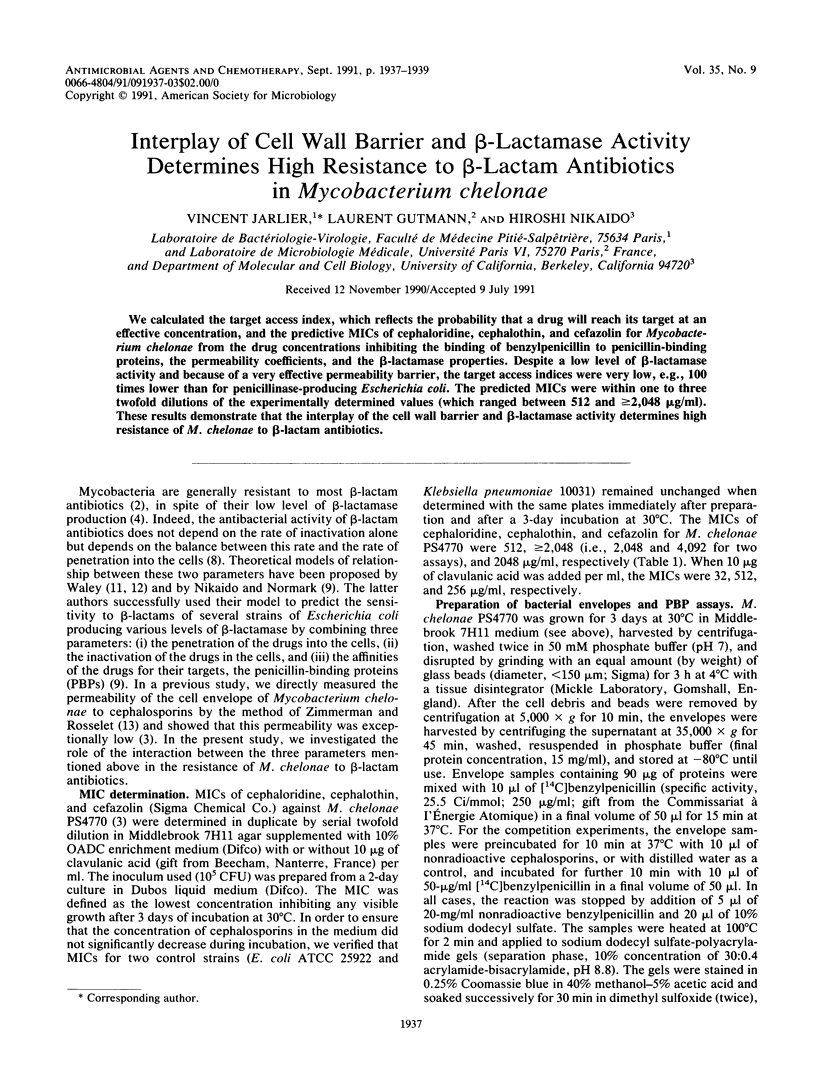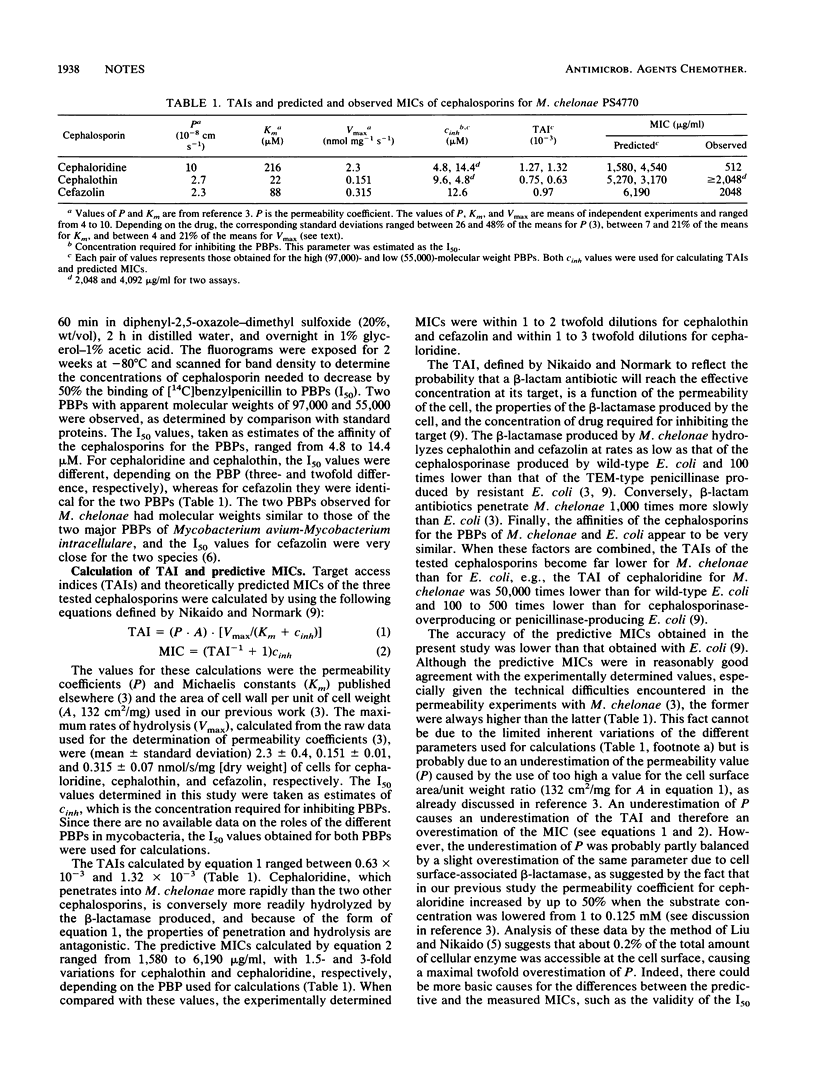Abstract
We calculated the target access index, which reflects the probability that a drug will reach its target at an effective concentration, and the predictive MICs of cephaloridine, cephalothin, and cefazolin for Mycobacterium chelonae from the drug concentrations inhibiting the binding of benzylpenicillin to penicillin-binding proteins, the permeability coefficients, and the beta-lactamase properties. Despite a low level of beta-lactamase activity and because of a very effective permeability barrier, the target access indices were very low, e.g., 100 times lower than for penicillinase-producing Escherichia coli. The predicted MICs were within one to three twofold dilutions of the experimentally determined values (which ranged between 512 and greater than or equal to 2,048 micrograms/ml). These results demonstrate that the interplay of the cell wall barrier and beta-lactamase activity determines high resistance of M. chelonae to beta-lactam antibiotics.
Full text
PDF


Selected References
These references are in PubMed. This may not be the complete list of references from this article.
- Cynamon M. H., Palmer G. S. In vitro susceptibility of Mycobacterium fortuitum to amoxicillin or cephalothin in combination with clavulanic acid. Antimicrob Agents Chemother. 1983 Jun;23(6):935–937. doi: 10.1128/aac.23.6.935. [DOI] [PMC free article] [PubMed] [Google Scholar]
- Finch R. Beta-lactam antibiotics and mycobacteria. J Antimicrob Chemother. 1986 Jul;18(1):6–8. doi: 10.1093/jac/18.1.6. [DOI] [PubMed] [Google Scholar]
- Jarlier V., Nikaido H. Permeability barrier to hydrophilic solutes in Mycobacterium chelonei. J Bacteriol. 1990 Mar;172(3):1418–1423. doi: 10.1128/jb.172.3.1418-1423.1990. [DOI] [PMC free article] [PubMed] [Google Scholar]
- Liu W., Nikaido H. Contribution of the cell-surface-associated enzyme in the Zimmermann-Rosselet assay of outer membrane permeability of beta-lactam antibiotics. Antimicrob Agents Chemother. 1991 Jan;35(1):177–179. doi: 10.1128/aac.35.1.177. [DOI] [PMC free article] [PubMed] [Google Scholar]
- Mizuguchi Y., Ogawa M., Udou T. Morphological changes induced by beta-lactam antibiotics in Mycobacterium avium-intracellulare complex. Antimicrob Agents Chemother. 1985 Apr;27(4):541–547. doi: 10.1128/aac.27.4.541. [DOI] [PMC free article] [PubMed] [Google Scholar]
- Nash D. R., Wallace R. J., Jr, Steingrube V. A., Udou T., Steele L. C., Forrester G. D. Characterization of beta-lactamases in Mycobacterium fortuitum including a role in beta-lactam resistance and evidence of partial inducibility. Am Rev Respir Dis. 1986 Dec;134(6):1276–1282. doi: 10.1164/arrd.1986.134.5.1276. [DOI] [PubMed] [Google Scholar]
- Nikaido H., Normark S. Sensitivity of Escherichia coli to various beta-lactams is determined by the interplay of outer membrane permeability and degradation by periplasmic beta-lactamases: a quantitative predictive treatment. Mol Microbiol. 1987 Jul;1(1):29–36. doi: 10.1111/j.1365-2958.1987.tb00523.x. [DOI] [PubMed] [Google Scholar]
- Nikaido H. Outer membrane barrier as a mechanism of antimicrobial resistance. Antimicrob Agents Chemother. 1989 Nov;33(11):1831–1836. doi: 10.1128/aac.33.11.1831. [DOI] [PMC free article] [PubMed] [Google Scholar]
- Udou T., Mizuguchi Y., Yamada T. Biochemical mechanisms of antibiotic resistance in a clinical isolate of Mycobacterium fortuitum. Presence of beta-lactamase and aminoglycoside-acetyltransferase and possible participation of altered drug transport on the resistance mechanism. Am Rev Respir Dis. 1986 Apr;133(4):653–657. doi: 10.1164/arrd.1986.133.4.653. [DOI] [PubMed] [Google Scholar]
- Waley S. G. An explicit model for bacterial resistance: application to beta-lactam antibiotics. Microbiol Sci. 1987 May;4(5):143–146. [PubMed] [Google Scholar]
- Zimmermann W., Rosselet A. Function of the outer membrane of Escherichia coli as a permeability barrier to beta-lactam antibiotics. Antimicrob Agents Chemother. 1977 Sep;12(3):368–372. doi: 10.1128/aac.12.3.368. [DOI] [PMC free article] [PubMed] [Google Scholar]


